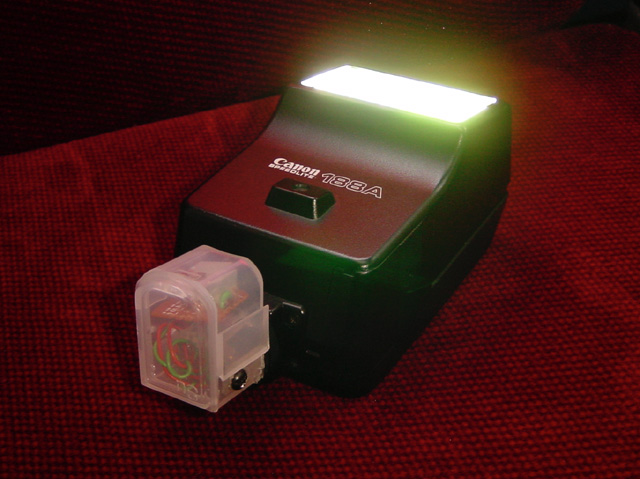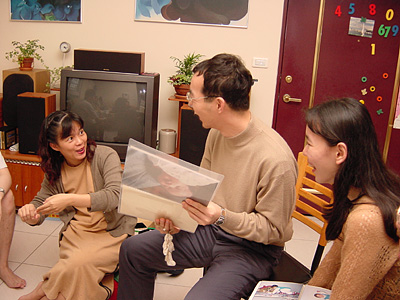
MY P1 GALLERY | P1 NOTES | COMMENTS
Slave flash
The P1 has a weak built-in flash with very limited range, and like all other built-in flashes, it will give you harsh shadows behind your subject and often a dark background.
Here's
a solution to these problems - the external slave
flash.
It is quite simple : a second flash fires at the same time you take your
picture and provides more light. Good quality and enough speed to capture
your kids and pets while they are running around, make this a very good
option for indoor photography.
You will need to buy an extra flash and a light sensitive "slave trigger". Some flashes have built-in sensors. A basic setup will cost from 50~150USD, most likely related to the strength of the flash you select.
Why use it? The reasons:
1.
Brighter
External flashes usually packs much
more illumination power, thus greater distance.
2.
Better looks
You can point the extra flash elsewhere
and from elsewhere. For instance, bouncing light off the ceiling is a
common method to create natural looks.
3.
Faster speed
More light means shorter exposure
time. The P1 has a 1/60sec shutter speed when using flash indoors(normal
AE), that is enough to freeze most of your subjects.
Reasons
not to like it:
You
lose portability and elegance of the machine.
TRUE. I like to think about it this way though:
you will always need an external flash to get pictures of this quality,
even if you own a larger camera. Besides, the slave flash is for indoor
family pictures, where portability is less of an issue.
I
can't find one. Don't they sell kits?
Yes, I believe there are kits ready to use
with your P1. Just find a well equipped camera shop and ask them for their
help. Don't forget to bring along your camera and a piece of tape.
It's
too complicated.
Not really. You'll have to
adjust the settings once when you get your new flash. Just tune the flash
output if your pictures look too dark or too bright. No need to push more
buttons afterwards, just the shutter release.
You
don't know where to place the extra flash.
This is the hardest part. You
can find brackets to attach to the flash at the local camera shop.
I
use my bracket like a handle. I hold it with my spare hand, and cross
my arms in a firm lock. If you don't like this idea, just leave it on
the table near the flash.
This
is what I am talking about. All you have to do is to carry an extra flash
like this one, about the size of another P1. Put it near the camera and
it will provide extra light for better indoor shots.
Look, no wires! We can use a light sensitive device like the small white
block attached to the flash and let the P1's built-in flash tell the slave
flash when to turn on.

The
P1 provides no plug connection by cable, so we need to provide extra means
for communication between the camera and the external flash.
The flash trigger is a tiny light sensitive device that connects to the
external flash and turns it on whenever it detects a strong pulse of light.
In this case, it is the P1's in-camera flash that activates it. You can
leave the slave flash quite a distance away from the camera and still
be able to trigger it.
Which flash to choose.
The
easy way
Any well equipped camera shop should be able
to help you out. Just ask. Don't
forget to bring along your camera and a piece of non-transparent tape.
The
hard way
If
you are determined to set it up by yourself. Ask for an old type, non-dedicated,
non-TTL flash with aperture and ISO settings. Many of the more modern
expensive TTL flashes today are dedicated to a certain brand of camera,
which allows settings and control to be achieved via communication with
the camera. Older flashes will provide the manual controls we need. For
our purpose, it is essential that flash power output can be controlled
by the flash itself.
Keep
in mind that not all triggers and flashes are compatible, and you should
do some searching in forums before buying them. A
combination I've heard of several times is a Vivitar 283 or 285HV flash
with a Wein slave trigger.
You may also see another specification: GN, or guide number is directly related to the power of the flash. A flash with GN value of 100 can be used with the P1 to a theoretical maximum distance around 30ft, sufficient for most conditions.
How
to use it?
The only thing to do is to adjust
the flash strength. You might have to experiment a certain amount of shots
when you first get your flash. The good part is, you can see the results
right away. There should be two or three "auto" settings on
the back panel of the flash. That controls your brightness directly. Examine
your shots and find out the best setting.
Another factor decides the flash output. The sensor located in front of the flash. Usually it should be directed toward your subject so it can "see" how much light is enough. Point the sensor towards different directions and see how it effects the brightness of your image.
As for the camera side, the shutter speed and aperture under flash mode is most often fixed, so there's not much adjusting to do. Set the in-camera flash strength to low and cover the camera flash with something partially transparent to weaken it.*
AE modes: normal, spot metering are best for general indoor shots. Twilight mode is also fine.
Optional
Reference:
Photo.net
flash forum
Blocking
the flash
Digi-slave
Wein
Triggers
BH
photo&video
Keyword search the forums at dpreview.com to find discussions concerning
slave flash and triggers.
*Most often it is best to minimize the camera's built-in flash for more natural looks. That is why it is useful to put something over the camera's flash, like a piece of tape. Yet we need enough light to trigger the slave. I'm currently using a piece of unexposed dark slide film that has been developed. Layers of white tape will work fine as well.
The P1 does not seem to have a "pre-flash" to evaluate white balance, which is sometimes seen in other digital cameras, so regular slave triggers should work fine. I made a simple homemade slave trigger for my old flash (Canon speedlite 188A), using one phototransistor and one variable resistor which costed me around 2USD. This should not be a good solution for other flashes though.
Samples
Here are some examples of what the slave flash can do. The flash is directed towards the ceiling for a soft bounce lighting effect. I had partially blocked the P1's in-camera flash with 2 layers of white tape, so there seems to be not much trace of it left in the picture. Just enough for the light sensor to activate the external flash.
CLICK ON PHOTOS TO SEE LARGER VERSION


